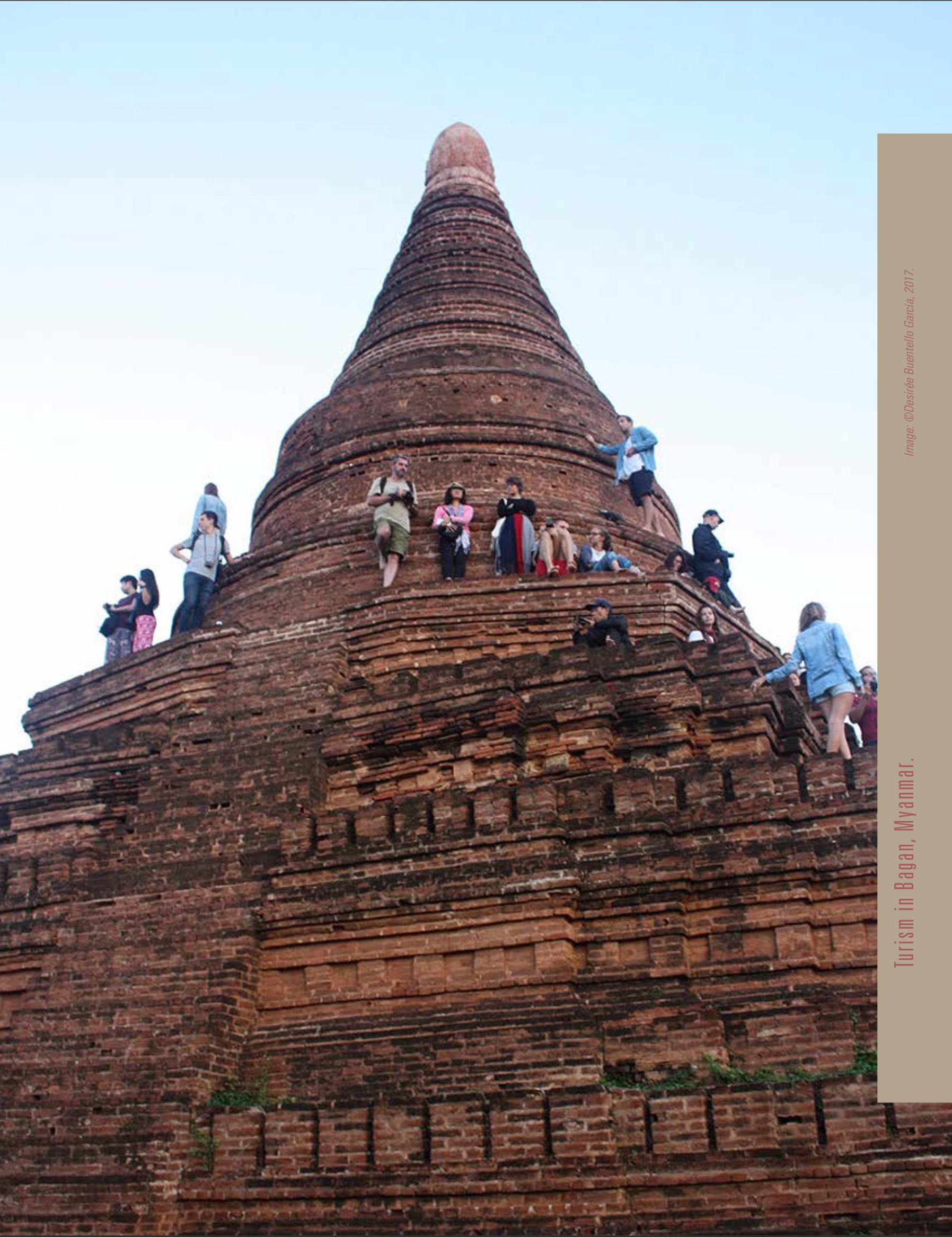Malabareando entre la “marca Patrimonio Mundial” y la recreación local en Bagan
Keywords:
Patrimonio Mundial, UNESCO, budismo, turismo, marca, comunidadAbstract
El sitio arqueológico de Bagan en Myanmar es uno de los principales destinos budistas de Asia. Su paisaje, constituido por más de tres mil monumentos, lo posiciona como uno de los sitios más visitados de Myanmar. Sin embargo, su posible inclusión en la Lista del Patrimonio Mundial plantea inquietudes entorno a la conservación de su patrimonio vivo. Algunos investigadores argumentan que el título de Patrimonio Mundial actúa como una “marca” placebo para atraer turismo cultural en busca de experiencias auténticas (Adie et al., 2018). No obstante, en lugares como Myanmar que hasta hace pocos años se encontraban en condiciones de aislamiento y en una situación post-conflicto, la pronta llegada del turismo podría representar una amenaza para sus dinámicas socioculturales. En este contexto, surgen tensiones al buscar el equilibrio entre mantener vivas las prácticas patrimoniales y adaptar el sitio a las necesidades del turismo.
Downloads
References
Bailey Ashton (2017) “Franchising our heritage: The UNESCO World Heritage brand”, Tourism Management Perspectives, 24: 48-53, disponible en: <http://isiarticles.com/bundles/Article/pre/pdf/84830.pdf> [consultado el 28 de mayo de 2019].
Adie, Bailey Ashton., Michael, Hall C., and Praya, Girish (2018) “World Heritage as a placebo brand: a comparative analysis of three sites and marketing implications”, Journal of Sustainable Tourism, 26 (3): 399-415.
Arizpe, Lourdes (2007) “The cultural politics of intangible Cultural Heritage”, Art Antiquity and Law, XII (4): 361-388, disponible en:<https://ial.uk.com/product/the-cultural-politics-of-intangible-cultural-heritage-%EF%BC%88lourdes-arizpe%EF%BC%89/> [consultado el 28 de mayo de 2019].
Barron, Laignee (2017) “‘Unesco-cide’: does World Heritage status do cities more harm than good?” The Guardian [en línea] (30 de agosto), disponible en: <https://www.theguardian.com/cities/2017/aug/30/unescocide-world-heritage-status-hurt-help-tourism> [consultado el 28 de mayo de 2019].
Buentello García, María Eugenia Desirée et al. (2018) Studio Bagan. Building in Heritage Context, Myanmar, Brandenburgische Technische Universität Cottbus-Senftenberg [documento electrónico], disponible en: <https://opus4.kobv.de/opus4-btu/frontdoor/ deliver/index/docId/4557/file/Studio_Bagan.pdf> [consultado el 23 de mayo de 2019].
Cleere, Henry (2011) “The Impact of World Heritage listing. Heritage driver of development”, ICOMOS 17th General Assembly, 2011-11-27 / 2011-12-02, Paris, France, III (1): 519-525, disponible en: <http://openarchive.icomos.org/1209/1/III-1-Article3_Cleere.pdf> [consultado el 23 de mayo de 2019].
Crabolu, Gloria (2015) Visitor Management at the Bagan Heritage Site. An evaluation of the current status with related recommendations, tesis de maestría en Tourism Destination Management, Breda University of Applied Science.
Dove, Cavelle (2017) “Giving trends in Myanmar: More than merit making”, Austrian Journal of South-East Asian Studies, 10 (2): 205-222, disponible en: <https://aseas.univie.ac.at/index.php/aseas/article/view/1813/1784> [consultado el 23 de mayo de 2019].
Edroma, Eric L. (2003) “Linking universal and local values for the sustainable management of World Heritage sites”, in Eléonor de Merod, Rieks Smeets and Carol Westrik (eds.), Linking universal and local values for the sustainable management of World Heritage sites, Paris, UNESCO (World Heritage Papers 13), pp. 36-42.
Hudson, Bob (2008) “Restoration and reconstruction of monuments at Bagan (Pagan), Myanmar (Burma), 1995-2008”, World Archaeology, 40 (4): 553-571.
King, Lisa M., and Halpenny, Elizabeth A. (2014) “Communicating the World Heritage brand: visitor awareness of UNESCO’s World Heritage symbol and the implications for sites, stakeholders and sustainable management”, Journal of Sustainable Tourism, 22 (5): 768-786.
Kraak, Anne Laura (2017a) “Impediments to a human rights-based approach to heritage conservation: the case of Bagan, Myanmar”, International Journal of Cultural Policy, 23 (4), pp. 433-445.
Kraak, Anne Laura (2017b) World Heritage and Human Rights in Bagan, Myanmar, doctoral thesis in Philosophy, Melbourne, Deakin University.
Logan, William (2016) “Whose heritage? Conflicting narratives and top-down and bottom-up approaches to heritage management in Yangon, Myanmar”, en: William Logan and Sophia Labadi (eds.), Urban Heritage, Development and Sustainability. International frameworks, national and local governance, New York, Routledge, pp. 256-273.
Mansfeld, Yoel (2018) “Tourism and Local Communities The Interplay between Tourism and the Community”, en Silvia de Ascaniis, Maria Gravari-Barbas and Lorenzo Cantoni (eds.), Tourism Management at UNESCO World Heritage Sites, Lugano, Università della Svizzera italiana/UNESCO, pp. 31-38.
Ministry of Hotels and Tourism (2013) Nay Pyi Taw [en línea], disponible en: <https://tourism.gov.mm/nay-pyi-taw/> [consultado el 23 de mayo de 2019].
Olsen, Daniel H. (2015) “Heritage, Tourism, and the Commodification of Religion”, Tourism Recreation Research, 28 (3): 99-104.
Prestes, Simone et al. (2019) Studio Bagan: Heritage Tourism, Conflicts and Chances, Brandenburgische Technische Universität Cottbus-Senftenberg [electronic document], disponible en: <https://opus4.kobv.de/opus4-btu/frontdoor/index/index/docId/4896> [consultado el 31 de Agosto de 2019].
Rich, Anna-Katharina, y Franck, Anja K. (2016) “Tourism development in Bagan, Myanmar: perceptions of its influences upon young peoples’ cultural identity”, Tourism Planning and Development, 13 (3): 333-350.
UNESCO World Heritage Centre (2019a) Convention Concerning the Protection of the World Cultural and Natural Heritage [en línea], disponible en: <https://whc.unesco.org/en/conventiontext/> [consultado el 23 de mayo de 2019].
UNESCO World Heritage Centre (2019b) Heritage of Religious Interest UNESCO Initiative on Heritage of Religious Interest [en línea], disponible en: <https://whc.unesco.org/en/religious-sacred-heritage/> [consultado el 23 de mayo de 2019].
UNESCO World Heritage Centre (2019c) Series [en línea], disponible en: <https://whc.unesco.org/en/series/> [consultado el 23 de mayo de 2019].
UNESCO World Heritage Centre (2019d), Socio-economic Impacts of World Heritage Listing [en línea], disponible en: <https://whc.unesco.org/en/socio-economic-impacts> [consultado el 23 de mayo de 2019].
UNESCO World Heritage Centre (2019e) Tentative List, Myanmar [en línea], disponible en: <https://whc.unesco.org/en/tentativelists/819/> [consultado el 23 de mayo de 2019].



